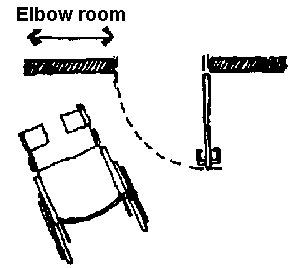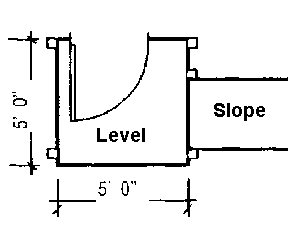

Top Landings: Top
landings should be nearly flush with the exterior door threshold.
1/2" is the typical maximum, particularly when a wheelchair
user is involved-anything larger will abruptly stop a chair's
relatively small front wheel, or is a tripping hazard for walkers.
Pay attention, too, to threshold specs if a new primary door is
being installed. If a prehung unit's going in, most don't have
the low threshold that's needed here.
For homes on footed foundations,
it's advisable in most parts of the state to bolt the top
landing into the home's foundation. This will avoid the potential
problem of the relatively lightweight ramp landing lifting up
due to frost heave and jamming under an outswinging door (like
a storm door). For unfooted structures, or temporary foundations
such as mobile homes on blocks, bolting the landing may still
be appropriate, but the ramp shouldn't be footed for the opposite
reason. Local soil conditions -e.g., clay vs. loam- will also
play a definite role here.
Top landings at minimum should
be at least 60" X 60" if there is an outswinging door,
with at least a 12" to 24" of "elbow room"
space provided off the door's handle side, particularly for a
person using mobility equipment. These dimensions give enough
room for a person to move off to the side while opening the door
without having to back up to get out of the way of its swing.
If there is no outswinging door, the landing may be somewhat
narrower- probably 48" at minimum.


Intermediate Landings:
Intermediate landings
for a long, in-line run of ramp can have the same width as the
running surface's, and length can range from 36 " to 60"-the
slope chosen is a factor to account for here, with a steeper slope
like a 1:12 requiring a longer distance in which to stop when
descending. A rough guideline to use is to install an intermediate
landing if a section of ramp covers more than a 30" change
in rise, but persons with limited stamina/control may need one
sooner than this. Dimensions for intermediate landings where
a direction change occurs depend on ramp width and the user's
circumstances. When a chair user's involved, a 48" X 48"
landing for a 90 degree turn is comfortable; for an 180 degree
turn, 48" by twice the width of the two ramp sections is
typical.
Bottom Landings: For
bottom landings, typical minimum dimensions when in-line travel
is involved are as wide as the ramp by about 48" long for
someone walking, and about 60" to 72" for a chair user.
Larger-width landings may be called for if the person has to
make a direction change (e.g. 90-degree turn). Make sure
the ramp/landing intersection doesn't have a "lip" greater
than 1/2" which would become a tripping/rolling hazard.